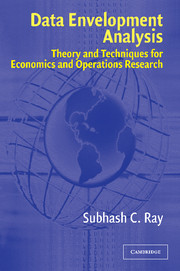Book contents
- Frontmatter
- Contents
- Preface
- 1 Introduction and Overview
- 2 Productivity Efficiency, and Data Envelopment Analysis
- 3 Variable Returns to Scale: Separating Technical and Scale Efficiencies
- 4 Extensions to the Basic DEA Models
- 5 Nonradial Models and Pareto–Koopmans Measures of Technical Efficiency
- 6 Efficiency Measurement without Convexity Assumption: Free Disposal Hull Analysis
- 7 Dealing with Slacks: Assurance Region/Cone Ratio Analysis, Weak Disposability, and Congestion
- 8 Efficiency of Merger and Breakup of Firms
- 9 Efficiency Analysis with Market Prices
- 10 Nonparametric Approaches in Production Economics
- 11 Measuring Total Productivity Change over Time
- 12 Stochastic Approaches to Data Envelopment Analysis
- 13 Looking Ahead
- References
- Index
8 - Efficiency of Merger and Breakup of Firms
Published online by Cambridge University Press: 24 November 2009
- Frontmatter
- Contents
- Preface
- 1 Introduction and Overview
- 2 Productivity Efficiency, and Data Envelopment Analysis
- 3 Variable Returns to Scale: Separating Technical and Scale Efficiencies
- 4 Extensions to the Basic DEA Models
- 5 Nonradial Models and Pareto–Koopmans Measures of Technical Efficiency
- 6 Efficiency Measurement without Convexity Assumption: Free Disposal Hull Analysis
- 7 Dealing with Slacks: Assurance Region/Cone Ratio Analysis, Weak Disposability, and Congestion
- 8 Efficiency of Merger and Breakup of Firms
- 9 Efficiency Analysis with Market Prices
- 10 Nonparametric Approaches in Production Economics
- 11 Measuring Total Productivity Change over Time
- 12 Stochastic Approaches to Data Envelopment Analysis
- 13 Looking Ahead
- References
- Index
Summary
Introduction
The primary focus in technical efficiency analysis is on the observed input and output quantities of any individual firm. A pair of input–output bundles is deemed efficient if there is no potential for a radial increase in outputs without any increase in inputs or for an equiproportionate reduction in inputs without a reduction in outputs. In evaluating the technical efficiency of the merger of a number of firms into a single firm, we go beyond the efficiency of the observed input–output bundles of the concerned firms. Instead, we consider the output producible by a single firm from the combined input bundles of these firms and compare it with the total output from the efficient operation of the existing firms operating as separate entities. Merger of firms is quite common in real life. Megamergers between very large banks in the United States or between major airlines like USAir and Piedmont are merely the more notable examples of the ongoing restructuring process in many industries in recent years. There are many reasons why firms decide to merge. But when the output from the combined input bundle is greater than the combined output from the constituent individual input bundles, merger improves technical efficiency.
The flip side of mergers is the breakup of a single firm into a number of smaller firms. The best example from recent years is the breakup of the Bell Telephone companies in the United States into a number of independent Baby Bell firms.
Information
- Type
- Chapter
- Information
- Data Envelopment AnalysisTheory and Techniques for Economics and Operations Research, pp. 187 - 207Publisher: Cambridge University PressPrint publication year: 2004
